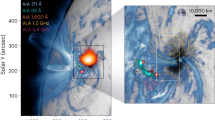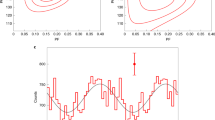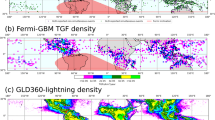Abstract
MEASUREMENTS of radio pulses from cosmic ray air showers in the frequency range 20 to 70 MHz have established the dominance of the geomagnetic mechanism1–4 and there is strong evidence from these experiments that the radio field strength increases with decreasing frequency. There have, however, been few observations at frequencies below 15 MHz where the background noise is considerably higher. At 2 MHz Allan et al.5 found a field strength of ∼750 µV/m/MHz for showers with a threshold primary energy of 1017 eV. At the same frequency Stubbs6 found a field strength of ∼0.8 µV/m/MHz for a threshold energy of 2 × 1014 eV. Hough et al.7 reported measurements at 3.6 MHz and compared their results with those of Allan et al. and Stubbs by normalizing all measurements to those expected on the axis of a shower of primary energy 1017 eV and incident normal to the Earth's magnetic field.
This is a preview of subscription content, access via your institution
Access options
Subscribe to this journal
Receive 51 print issues and online access
$199.00 per year
only $3.90 per issue
Buy this article
- Purchase on Springer Link
- Instant access to full article PDF
Prices may be subject to local taxes which are calculated during checkout
Similar content being viewed by others
References
Kahn, F. D., and Lerche, I., Proc. Roy. Soc., A,289, 206 (1966).
Colgate, S. A., J. Geophys. Res., 72, 4869 (1967).
Prescott, J. R., Hough, J. H., and Pidcock, J. K., Nature Physical Science, 233, 109 (1971).
Allan, H. R., Jones, J. K., Mandolesi, N., Prah, J. H., and Shutie, P., Twelfth Int. Conf. Cosmic Rays, Hobart, Conference Papers, 3, 1097 (Univ. Tasmania, 1971).
Allan, H. R., Clay, R. W., and Jones, J. K., Nature, 225, 253 (1970).
Stubbs, T. J., Nature Physical Science, 230, 172 (1971).
Hough, J. H., Prescott, J. R., and Clay, R. W., Nature Physical Science, 232, 14 (1971).
Briggs, B. H., Elford, W. G., Felgate, D. G., Golley, M. G., Rossiter, D. E., and Smith, J. W., Nature, 223, 1321 (1969).
Jelley, J. V., Cerenkov Radiation and its Applications, 233 (Pergamon, 1958).
Rossiter, P. E., Nature, 228, 1299 (1970).
Hough, J. H., and Prescott, J. R., Nature, 227, 590 (1970).
Prescott, J. R., Hough, J. H., and Pidcock, J. K., Acta Physica Hungarica, 29, Suppl. 3, 717 (1970).
Vernov, C. N., Khristiansen, G. B., Abrosimov, A. T., Atrashkevich, V. N., Vedeneev, O. V., and Neat, K. F., Izv. Akad. Nauk. USSR, 34, 1995 (1970).
Allan, H. R., Clay, R. W., and Jones, J. K., Nature, 227, 1116 (1970).
Author information
Authors and Affiliations
Rights and permissions
About this article
Cite this article
FELGATE, D., STUBBS, T. Polarization of Extensive Air Shower Emission at 6 MHz. Nature 239, 151–152 (1972). https://doi.org/10.1038/239151a0
Received:
Issue Date:
DOI: https://doi.org/10.1038/239151a0
This article is cited by
-
Transition radiation model for LF radio emission produced by ultrahigh-energy cosmic rays
Indian Journal of Physics (2016)
-
Vasoconstriction by Noradrenaline in the Brain
Nature New Biology (1973)
-
Low Frequency Radio Emission from Extensive Air Showers
Nature (1973)
Comments
By submitting a comment you agree to abide by our Terms and Community Guidelines. If you find something abusive or that does not comply with our terms or guidelines please flag it as inappropriate.



